Are you considering laser dentistry? Here’s a comprehensive guide on everything you need to know before purchasing one for your own practice.
The world of advanced dental treatments has expanded greatly in recent years, and lasers have emerged as one of the most exciting options. With a multitude of benefits, it’s no wonder that more and more dentists are adding lasers to their list of services.
Laser dentistry is an advanced technique that uses laser technology to treat a variety of dental conditions and diseases. Over the past few decades, lasers have been developed that allow dentists to perform procedures without traditional instruments like scalpels.
This technique provides a minimally invasive option for procedures such as scaling and root planing, root canals, fillings, and cosmetic treatments like gum reshaping and teeth whitening. In this article, we’ll explore the different types of lasers used in dentistry and their various applications, as well as the advantages and disadvantages of laser dentistry for both dentists and patients.
Applications of lasers in dentistry
Dentists are using lasers for a variety of procedures, including removing tooth decay, reshaping gums, reducing oral bacteria, treating cold sores, and hardening fillings. Lasers can also be used for surgery, to enhance tooth bleaching and to remove diseased tooth structure before restoration.
Lasers can be broadly categorized as hard or soft tissue lasers. Soft tissue lasers are ideal for cutting and contouring the gums safely, while hard tissue lasers are ideal for trimming and reshaping tooth and bone.
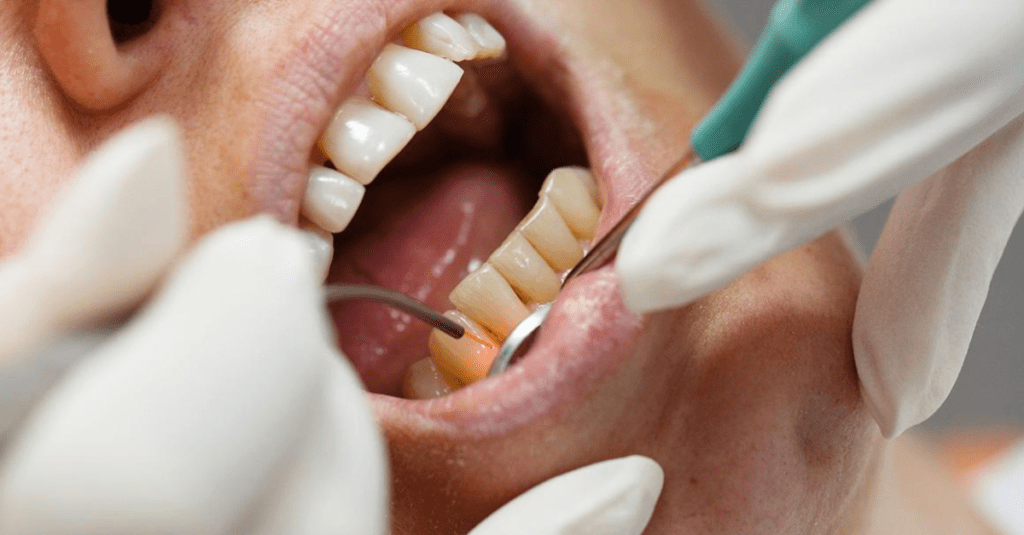
Soft Tissue Laser Procedures
Soft tissue laser procedures have become increasingly popular, as they are painless, non-invasive, and require little to no anesthesia. A laser gingivectomy is a cosmetic dental procedure used to reshape the gum line by removing gum tissue. The procedure is commonly used to reduce a gummy smile. Laser frenectomy is another soft tissue procedure that removes or reduces the frenum or frenulum, a piece of connective tissue between the upper or lower lip and the gums. This can prevent gaps between the teeth (diastema) and gum tissue defects.
Hard Tissue Laser Procedures
For hard tissue procedures, lasers can detect tooth decay (cavities) early and remove them without using traditional drilling methods. Additionally, lasers can be used for crown lengthening, a procedure that reshapes the underlying bone to expose healthy tooth structure. Dentin hypersensitivity, which occurs when enamel is so worn that the tubules underneath it are exposed, can also be treated with laser therapy.
Laser-assisted root canal therapy involves the use of a laser to access the root canal, remove infected tissue, decontaminate and shape the canal, and fill the canal with sterile material. The precision of lasers makes root canal therapy less invasive and more comfortable for patients.
Other Laser Procedures
Lasers can be used for various other dental procedures, including tartar removal, treating canker sores, leukoplakia, and other oral lesions. The technology can regenerate damaged nerves, scars, and blood vessels and remove benign (non-cancerous) tumours in the mouth. Additionally, lasers can be used to remove extra throat tissue that causes obstructive sleep apnea (OSA), expose wisdom teeth before removal, and reduce jaw pain caused by temporomandibular joint dysfunction (TMD).
Types of Dental Lasers
There are four common types of lasers used in dentistry: Diode, Nd:YAG, Erbium, and CO2. Each type of laser has a unique laser-tissue interaction based on wavelength, making them suitable for different dental procedures.
Erbium Lasers (2780 – 2940 nm)
Erbium lasers are capable of treating both hard and soft tissues and have received the most FDA clearances for dental procedures. Their primary chromophore is water, with some absorption occurring in hydroxyapatite.

Photothermal interactions dominate in soft tissue procedures and photodisruptive interactions in hard tissue. Proper use of these lasers results in excellent thermal relaxation and very little collateral thermal damage to tissues.
Nd:YAG Lasers (1064 nm)
Nd:YAG lasers have unique biostimulative properties and are primarily used for periodontal treatments. These lasers have a proclivity for pigmented tissue, making them effective for debridement and disinfection of periodontal pockets.
Nd:YAG lasers can also safely coagulate blood, which is beneficial for postoperative procedures. Proper use of these lasers maximizes their effectiveness in tissue treatment and bacterial decontamination.
Diode Lasers (805 – 1064 nm)
Diode lasers are becoming increasingly popular in dentistry due to their compact size and relatively affordable pricing. They are soft tissue only and operate using monochromatic light produced by a semiconductor.
Each type of laser has a unique laser-tissue interaction based on wavelength, making them suitable for different dental procedures.
Diode lasers can be used in both contact and non-contact mode and can function with continuous wave or gated pulse modes. They are not capable of free running pulsed mode. These lasers are effective for treating pigmented tissues and their absorption spectrum is similar to that of Nd:YAG lasers.
CO2 Lasers (9300 – 10,600 nm)
CO2 lasers are generally used for soft tissue procedures. These lasers operate in gated wave modes and are excellent tools for incising tissue. They offer improved surgical control with less charring of tissue, resulting in a more comfortable post-operative experience for patients. CO2 lasers are also effective for ablation and vaporization of leukoplakia and dysplasia.
There are also CO2 lasers that have been developed for use in hard tissue dental procedures. The laser’s CO2 molecule uses an oxygen isotope that creates a beam at 9300 nm, with a high absorption affinity for hydroxyapatite. This allows for efficient vaporization of tooth structure, including enamel, dentin, and bone.
Advantages of Laser Dentistry
Dental lasers are a cutting-edge technology that are quickly becoming a game-changer in the world of dentistry. They offer a range of benefits over traditional methods, including less blood loss, lower risk of infection, reduced pain and anxiety for patients, and greater precision for dentists. If you’re considering adding laser treatments to your own practice, here are some of the ways in which dental lasers are changing the field of dentistry for the better, and why they’re quickly becoming a go-to tool for modern dental practice.

Less Invasive Procedures
One of the most significant advantages of laser dentistry is the ability to perform minimally invasive procedures without scalpels or traditional instruments. This means that there is typically less damage to the surrounding teeth and gums.
The lasers are known to improve blood clotting, which leads to less blood loss during procedures. They have also been found to reduce the risk of infection by killing bacteria on contact.
Patients tend to experience less of pain when procedures are performed with a dental laser and bleeding is also reduced. Even the chances of swelling are minimized when compared to conventional tools, making recovery times generally faster.
Allows More Precision
Another big advantage of using dental lasers is their ability to provide precise and accurate results in a range of dental procedures. Traditional dental instruments can be effective, but they can also be difficult to control, leading to a higher risk of error or damage to surrounding tissue.
Laser dentistry provides a minimally invasive option for procedures such as scaling and root planing, root canals, fillings, and cosmetic treatments like gum reshaping and teeth whitening.
Dental lasers, on the other hand, offer highly precise control over the area of treatment, allowing dentists to work with greater accuracy and finesse. This is especially important in delicate procedures that involve highly sensitive areas, such as the gums, tongue, or other soft tissues in the mouth.
Reduces Patient Anxiety
Patients who experience anxiety when visiting the dentist may find laser dentistry more comfortable, as there are no loud or annoying noises during the treatment process. Additionally, laser dentistry is highly efficient, meaning that treatment times tend to be faster than with other dental procedures.
Laser dentistry is relatively safe when proper safety precautions are taken, such as ensuring that all individuals in the room wear eye protection.
Disadvantages of Laser Dentistry
Despite the many benefits of laser dentistry, there are also some potential downsides that should be considered. For one, not all dental procedures can be performed with lasers, and traditional methods may still be necessary in some cases. As a dentist, there are also several factors to keep in mind when deciding whether laser technology is the right fit for your practice.
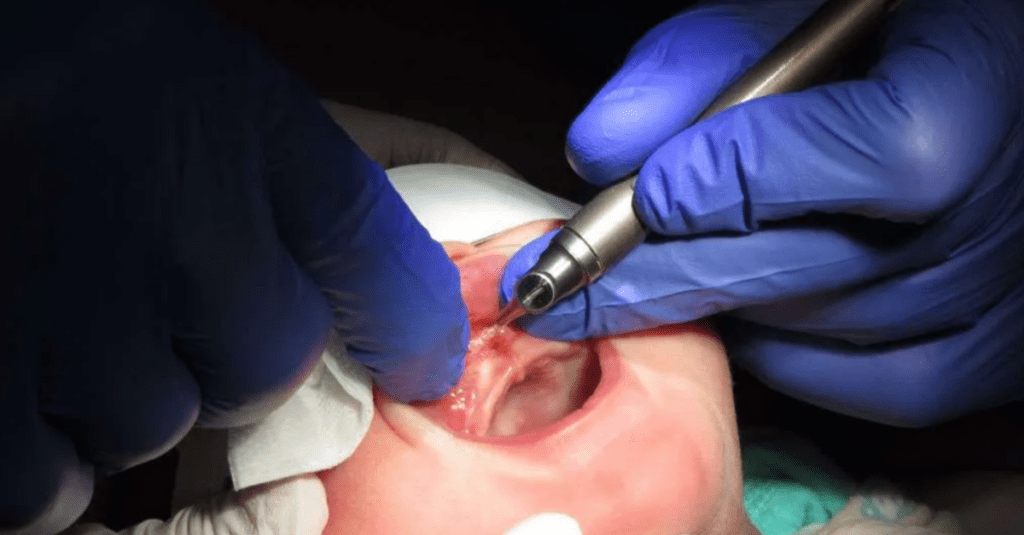
Cost
Dental lasers require specialized training and equipment, which can make them more expensive to use than traditional dental tools. This means they may require additional investment on the part of the practice.
Another potential disadvantage of laser dentistry is that it may not be covered by all insurance plans, which means patients may need to pay out of pocket for treatments. Dentists should be aware of these potential financial considerations and communicate them clearly with their patients.
Not Accessible for All Patients
It’s also worth noting that while lasers can be effective for many dental procedures, they cannot be used on teeth with fillings already in place.
Furthermore, lasers are not suitable for removing damaged oral restorations like bridges or crowns. They also cannot be used to treat interdental cavities or excessive tooth decay, which may require more invasive treatment.
This means that traditional methods may still be necessary for certain treatments, as lasers may not be an option for some patients.
For one, not all dental procedures can be performed with lasers, and traditional methods may still be necessary in some cases.
Potential Safety Risks
When considering the use of laser dentistry in your practice, it’s important to be aware of the potential risks involved. While dental lasers are generally considered safe, there are certain hazards that should be taken into account.
One risk associated with laser dentistry is the potential for fire or electrical hazards, which can result in serious accidents. Therefore, it’s important to carefully follow all safety protocols and to be aware of the potential dangers when using laser equipment.
In addition, there is also a risk of injury to the soft tissues in the mouth or to the eyes. To reduce these hazards and guarantee the safety of both the patient and the dental team, it’s crucial to utilise the proper protective equipment, such as eyewear and shields.
Things to consider when choosing dental lasers
Dental lasers are becoming increasingly popular among clinicians due to their ability to perform procedures with greater precision, speed, and comfort. However, not all dental lasers are created equal, and clinicians should consider several factors before purchasing a laser for their own practice.
Power and Emission Method
One of the critical factors to consider is the laser’s power, which determines its ability to perform a given procedure. Lasers come in various power options, and the higher the peak power the laser offers, the faster and cleaner its cuts will be. Whether you want super-pulsing power, which fires 50 times a second and turns off between each pulse, is also essential to consider.
User-Friendly Features
Another essential factor to consider when choosing a dental laser is its ease of use. A laser with features that simplify procedures, like pre-programmed settings and a simple user interface, can save clinicians time, frustration, and money with every use. These built-in features help reduce the learning curve and allow clinicians to focus on providing optimal care to their patients.
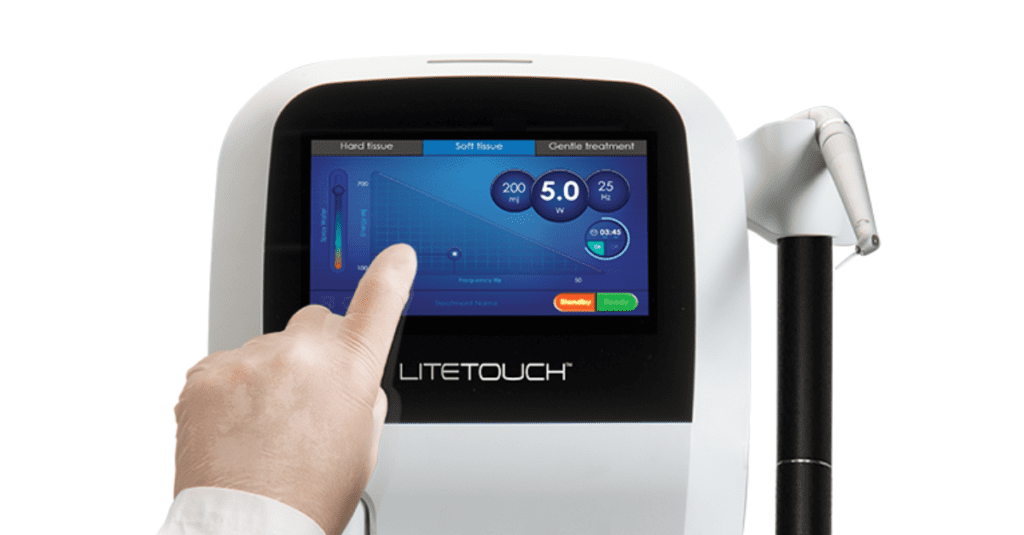
Wavelength
Clinicians must also consider the wavelength of the laser they choose. Different wavelengths can affect skin pigmentation and water absorption properties differently. For example, an 810 nm wavelength laser is optimal for melanin absorption, while a 980 nm wavelength works better for water absorption.
Best Dental Lasers
With a range of options available on the market, it can be challenging to determine which laser is best suited for a particular practice. In this section, we explore some of the best dental lasers currently available as well as their features and benefits.
Epic Pro by Biolase

Biolase’s Epic Pro diode laser is a tool designed for high speed, consistency, safety, and precision. Its automatic power control ensures reliable cutting conditions and adjusts laser energy in real time. The Super Thermal Pulse provides soft tissue with ample time to relax between pulses, enhancing precision and safety. This laser also features a built-in tip integrity indicator and customizable modes for maximum control and flexibility.
Features:
- Surgical diode laser
- 2 wavelengths (940 nm and 980 nm)
- Over 20 clinical presets
- Automatic power control
- Super thermal pulse mode
- Epic Pro monitors that measure laser tip temperature
Gemini EVO by Ultradent Products
Ultradent Products’ Gemini EVO laser is a versatile and powerful tool for dental practices. With a 100-watt peak power and a dual-wavelength design, this laser offers five times more power than its predecessor, resulting in faster cutting, less heat, and clean incisions in soft tissue. Its user-friendly pre-sets make it easy to use for a range of procedures.
Features:
- Dual wavelengths (810 nm + 980 nm)
- Autoclavable handpiece
- Sleek display and user interface
- Adjustable tip illumination
- 3 PBM adapters included (3 mm, 7 mm, and 25 mm)
- Connects to Wi-Fi
- Single-use bendable tips
- 100 watts of super-pulsed power
- 2-year manufacturer’s warranty
Pioneer Elite by CAO Group

CAO Group’s Pioneer Elite laser offers convenience, flexibility, and portability. With an ergonomic handle and docking cradle, this laser system is reportedly easy to operate. It comes standard with over 30 pre-set clinical procedures, with the ability to create custom programs for even greater flexibility.
Features:
- Disposable Fiber Tips
- 810 nm Wavelength
- Ergonomic handle
- Invertible Touch Screen
- 3-Watt Max Power Output
- Portable Lithium Battery
- Fiber Cable Assembly with Removable Handpiece Sleeve
- Customizable pre-sets
- 2-year manufacturer warranty
Aquamarine by FONA Dental

FONA Dental presents Aquamarine, a diode laser that allows for high precision and efficiency in dental procedures. Its 445 nm wavelength provides quicker cutting and less power usage, resulting in faster treatment with minimized bleeding and thermal damage. The built-in battery offers a mobile treatment solution for over an hour of uninterrupted use.
Features:
- Touchscreen user interface
- Wide range of applications
- Finger-activated switch laser
- 445 nm wavelength
- Less power required
- Higher haemoglobin absorption
SOL Desktop Laser by Denmat
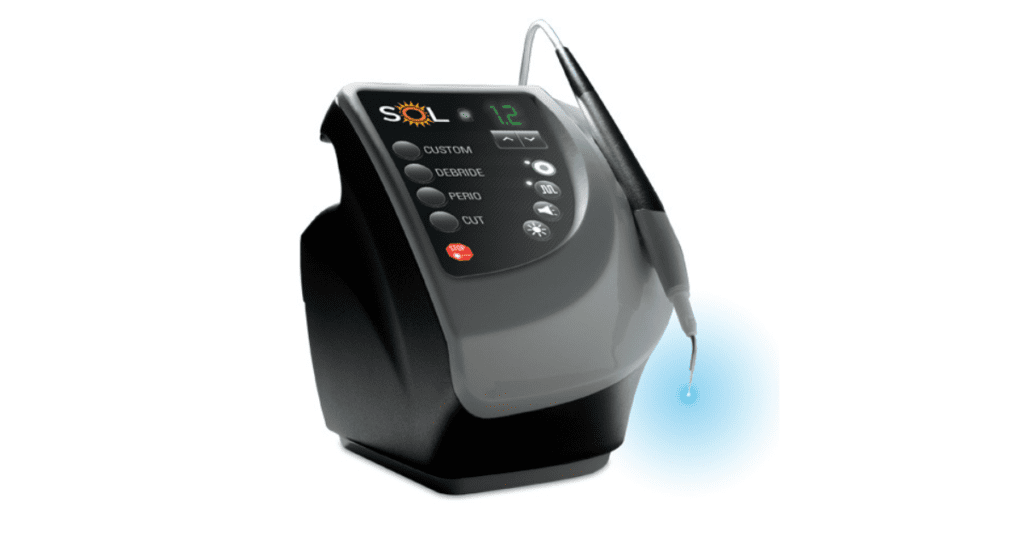
The SOL Desktop dental laser by Denmat provides portability, power, and precision for dental professionals. It has a simple interface make laser dentistry more accessible, while a high-contrast aiming beam helps to ensure accuracy during procedures. The diode laser is designed to be cost-effective and is suitable for use by the entire dental team.
Features:
- SOL Diode Laser System with Hand Piece and Optical Fiber
- Blue laser light aiming beam
- Max Power: 3 Watts in continuous laser wavelength mode and 5 Watts in pulse mode
- Disposable tips available
- SOL Wireless Foot Switch
Solea by Convergent Dental
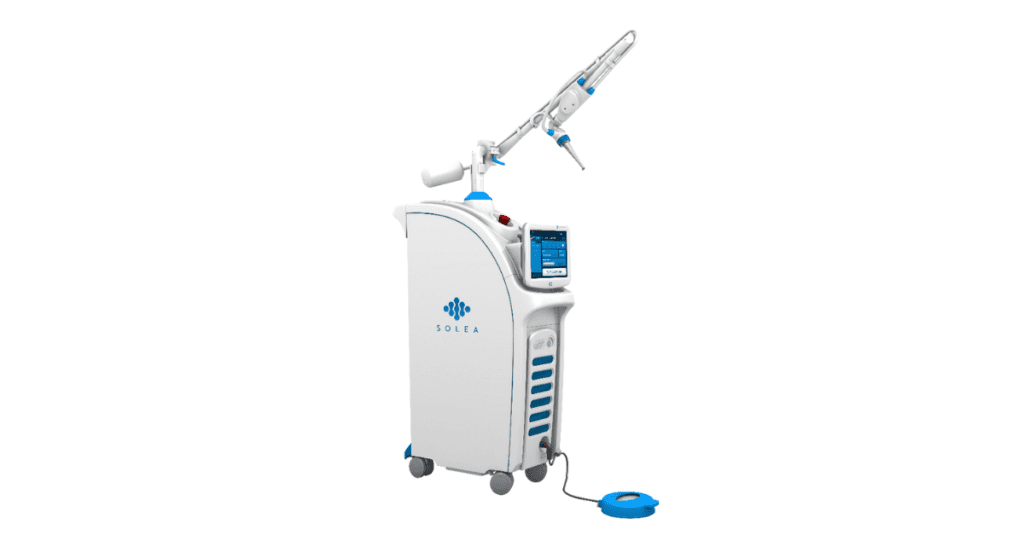
Solea by Convergent Dental can cut any tissue with a single setting. This approach is designed to work for tooth structure as well as bone and soft tissue, enabling dentists to deliver anaesthesia-free, blood-free, suture-free, and pain-free results.
Features:
- variable speed foot pedal
- able to select spot sizes
- galvos (computer-controlled motors for the mirrors inside the handpiece)
- 9.3 µm CO2 Laser
Horizon Dental Laser System by Summus Medical Laser
Summus Medical Laser’s Horizon Dental Laser System is a first-of-its-kind complete dental laser system. It combines four different, independently-controlled wavelengths to achieve a therapeutic laser dose in less time with condition-specific protocols. This system features expert training, marketing, and clinical support, as well as a practice management tool that provides real-time support for integrating laser therapy into your practice.
Features:
- Easy to use touchscreen interface
- Independent control of wavelengths
- Unlimited patient history data
- 3-year manufacturer’s warranty
- 2 hand piece optics
- 4 Wavelengths (650 nm, 810 nm, 915 nm, and 980 nm)
LightWalker by Fotona
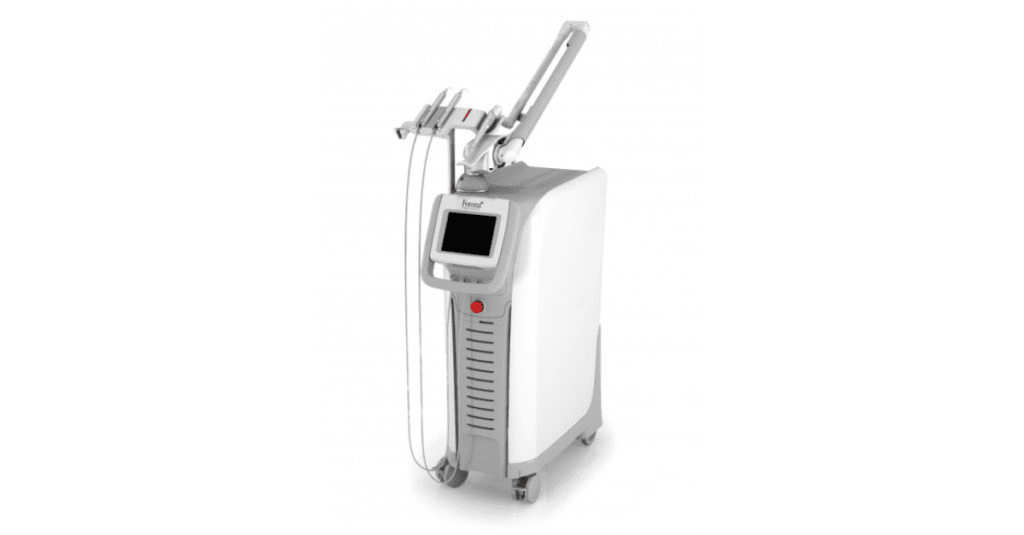
The Fotona LightWalker offers endless versatility through two proven wavelengths: Nd:YAG and Er:YAG. These wavelengths provide high levels of efficacy for a wide range of procedures, with unrivalled power and precise pulse control. The system’s OPTOflex articulated arm delivers 20 watts of power, making it a powerful tool for dental practices.
Features:
- 2 wavelengths (1064 nm and 2940 nm)
- Adaptive structured pulse technology
- Fotona’s Quantum Square Pulse mode for improved ablation efficacy
- Spray temperature regulation
- Dual fiber system
- Fontona’s Variable Square pulse for better precision
Precise LTM by CAO Group

The Precise LTM diode laser system by CAO group is a low-cost yet highly effective option for performing soft-tissue procedures. This laser is designed to be easy to learn and operate, with four custom settings for procedures such as gingival contouring, gingivectomy, abscess care, and frenum release. Its state-of-the-art diode technology offers the most predictable manipulation of oral soft tissue.
Features:
- Ergonomic pen-style handpiece
- Capable of a variety of soft tissue surgical procedures
- Continuous, retracting/extending fiber
- Compact, portable design
- 20′ Fiber Cartridge
- 2 Autoclavable Handpieces
- 6-hour Online Training Program
Conclusion
While laser dentistry can be a valuable tool in your practice, it’s important to weigh the potential benefits and drawbacks, and to carefully evaluate each patient’s individual needs to determine the best course of treatment. By doing so, you can provide the highest quality care to your patients while ensuring the long-term success of your practice.
The information and viewpoints presented in the above news piece or article do not necessarily reflect the official stance or policy of Dental Resource Asia or the DRA Journal. While we strive to ensure the accuracy of our content, Dental Resource Asia (DRA) or DRA Journal cannot guarantee the constant correctness, comprehensiveness, or timeliness of all the information contained within this website or journal.
Please be aware that all product details, product specifications, and data on this website or journal may be modified without prior notice in order to enhance reliability, functionality, design, or for other reasons.
The content contributed by our bloggers or authors represents their personal opinions and is not intended to defame or discredit any religion, ethnic group, club, organisation, company, individual, or any entity or individual.

